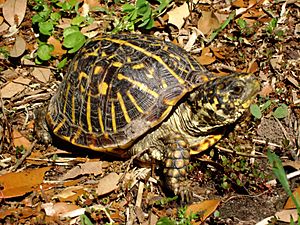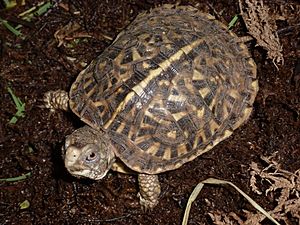Ornate box turtle facts for kids
Quick facts for kids Terrapene ornata ornata |
|
|---|---|
 |
|
| Ornate box turtle (Terrapene ornata) | |
| Conservation status | |
| Scientific classification |
|
| Kingdom: | Animalia |
| Phylum: | Chordata |
| Class: | Reptilia |
| Order: | Testudines |
| Suborder: | Cryptodira |
| Family: | Emydidae |
| Genus: | Terrapene |
| Species: | |
| Subspecies: |
T. o. ornata
|
| Trinomial name | |
| Terrapene ornata ornata (Agassiz, 1857)
|
|
| Synonyms | |
|
|
The ornate box turtle (Terrapene ornata ornata) is a small turtle that lives on land. It is one of only two land turtle species found in the Great Plains region of the United States. This turtle is also the state reptile of Kansas.
Ornate box turtles are currently listed as "threatened" in Illinois. They are also protected in six other Midwestern states. These states include Colorado, Iowa, Indiana, Nebraska, Kansas, and Wisconsin.
Males and females look quite similar. However, males are often smaller. Their shells can be gray, red-brown, or black. They have bright yellow lines that go from the center of the shell to its edges. You can tell males from females by a few clues. Males have a large curved claw on their back feet. Their tail is longer and thicker. They also have reddish color on their legs and sometimes on their jaw.
Contents
Where Ornate Box Turtles Live
The ornate box turtle lives across a large part of the Midwest. Their range stretches from Wisconsin down to the Gulf of Mexico. It also goes from Louisiana all the way to Colorado. These turtles were first found in Nebraska in 1795. People reported seeing "vast numbers" of them there.
These turtles usually live in grasslands. They prefer dry land over water. They have been found in almost all types of habitats in the Great Plains. However, they like open grass or prairie lands the most.
Important Habitats for Survival
Ornate box turtles need three special types of places to survive. These are called microhabitats.
- They need grassy areas, like prairies, for finding food. These areas should also have some standing water.
- Females need places where they can lay their eggs. They also need spots to dig into the soil for winter.
- Turtles need resting spots to control their body temperature. They can bury themselves in the soil to stay cool in summer. This also helps them avoid drying out.
Water is important for these turtles. It helps them control their body temperature when it is hot. It also helps them get enough water after they wake up from winter sleep. But they do not spend much time in rivers or ponds.
How Turtles Control Body Temperature
The ornate box turtle is a reptile. This means it is ectothermic. Its body temperature changes with the temperature around it. This also affects how much the turtle moves. When it is very hot, the turtle moves less. Moving too much makes its body temperature rise even more. When it is cooler, like at dawn or dusk, the turtle is more active.
Turtles also use their habitat to help control their temperature. They often use Shrubs for shade. This shade helps them stay cool. Open sandy areas are also important. Turtles can dig holes there to bury themselves.
Winter Sleep
In winter, ornate box turtles go underground to hibernate. This is like a long sleep. They usually dig their burrows around the same time in the fall. They then come out within 7 to 14 days of each other in the spring. They can even survive when the soil around them freezes for many days.
In Nebraska, turtles dug their winter burrows after October. They stayed there until April. Each turtle usually had its own burrow.
Turtle Home Ranges
The area where an ornate box turtle lives is called its home range. The size of this area can be very different. It can be as small as 0.12 hectares. It can also be as large as 36.4 hectares. Many things can affect the size of a turtle's home range. These include the time of year, the turtle's size and age, and if there are roads nearby.
Ornate box turtles often return to the same area year after year. This is called philopatry. They usually prefer the same type of habitat they started in. Turtles were twice as likely to be found in the same type of habitat. They were even more likely to be in a habitat right next to their original one.
Lifespan and Life Cycle
Ornate box turtles can live for a long time. They have been known to live from 32 to 37 years. Studies show that there are often more females than males. This might be because of temperature. If eggs are kept at 29 °C (84 °F), all the hatchlings will be female. In nature, a mix of temperature and other things likely causes more females to be born.
Young Turtle Dangers
Many animals hunt young turtles. These predators include crows, raptors (like hawks), ravens, domestic cats, and dogs. Other dangers are opossums, raccoons, skunks, and snakes. Even adult box turtles might eat young ones.
Adult turtles have few ways to defend themselves. They can pull their head and legs into their shell and close it up. They might also bite if someone handles them.
Turtle Health
For a long time, not much was known about diseases in these turtles. Early studies showed that some flies could infest their legs. This made it hard for the turtles to move. They could even die from not being able to find food. More recently, scientists found that turtles can get respiratory (breathing) problems. They can also have problems with their metabolism or shell diseases. These are common in other land turtles. Poor nutrition can also make these diseases worse.
How to Tell a Turtle's Age
For many years, people have tried to guess a turtle's age by counting growth rings. These rings form on parts of the shell, like scales. The older a turtle gets, the more rings it forms. This is similar to how you count rings on a tree. However, using these rings to guess age is not always correct. A turtle's shell does get bigger as it gets older. But it also gets heavier to carry around.
Threats to Ornate Box Turtles
Natural Threats
The ornate box turtle faces some natural challenges. They start having babies later in life. They also do not have many babies. Many young turtles do not survive. These things make it hard for their population to grow quickly. Young turtles are easy prey until their shells become strong. Their shells protect them from most things, but not from cars. Losing older female turtles is a big problem. This is because they are not replaced very quickly.
Weather can also be a threat. The temperature strongly affects if a turtle egg becomes a male or female. Extreme weather can cause too many males or too many females to be born. If a group of turtles has mostly one sex for several years, it can be a problem. This can lead to a small gene pool. A small gene pool means less variety in their genes. This can cause inbreeding and more deaths. This is a bigger problem for animals that live a long time. The loss of genetic variety might not be seen right away. But once it happens, it is harder for the population to recover.
Another problem is that ornate box turtles like to stay in the same area. If something bad happens to that area, they are more vulnerable.
Human Threats
Ornate box turtles live on land. This makes them sensitive to human activities. These include destroying their homes, new species being introduced, collecting them, pollution, and climate change.
- Farming: Farming in the Great Plains has caused big problems. It has taken away many acres of land. This destroys turtle habitats. It also leads to more traffic. This creates small, isolated areas of prairie. These small areas also have more "edge habitats." This means more predators live there. This increases the number of turtles eaten. Other farming problems include fences, water troughs, and farm machinery. Cattle can also accidentally step on turtles.
- Building Homes: Building houses and other structures also destroys habitats. It leads to more turtles being taken as pets. Dogs can also hunt them. More crows and raccoons live near human areas. These animals also hunt turtles. More roads are built where houses are. Turtles sometimes eat animals killed on roads. But this also means more turtles get hit by cars.
- Collecting Turtles: Many ornate box turtles have been collected to be sold as pets. People have always collected some turtles. Selling them commercially has greatly affected turtle populations. If this continues, the number of turtles will drop sharply.
Helping Ornate Box Turtles
The International Union for Conservation of Nature says the ornate box turtle is "near threatened." In some states, like Nebraska, Kansas, and Colorado, the turtle population is "secure." But in South Dakota, it is "imperiled." In Wyoming, it is "critically imperiled."
It is hard to make good plans to protect these turtles. This is because of how they live. It seems the best plans will focus on helping older female turtles survive. This is better than just focusing on hatchlings.
One important step is to find out how many ornate box turtles actually exist. It also needs to be made illegal to collect them for pets or for sale. Some states have already done this. Also, people should not release pet box turtles into the wild. Pet turtles can carry diseases, like respiratory infections. These diseases can harm wild turtles. Protecting the best habitats is also a very important way to help them.
The biggest problem for ornate box turtles is contact with humans. Any action that reduces this contact is helpful. Keeping large areas of their habitat undisturbed is also good. When managing weeds, use as little herbicide as possible. It is important to know what chemicals are in the herbicides and how they affect turtles. Using fire or mowing to control weeds should be done carefully. This should happen when turtles are not active or are in their burrows.
It might be hard to stop people from collecting turtles. This is because people like to see turtles and nature. Nebraska and Louisiana have made it illegal to collect ornate box turtles. But New Mexico and Texas have not. Teaching the public about the dangers to ornate box turtles is important. This should be part of conservation efforts.
One idea to help is to remove predators from areas with many turtles. One study found that removing raccoons helped. But this also brings up questions about the balance of nature. Some biologists have suggested moving turtles from healthy groups to struggling ones. But this is difficult and might be a last choice.
Losing their habitat is the biggest problem for the ornate box turtle. Small, isolated habitat areas lead to isolated groups of turtles. These groups lose genetic variety. This makes it harder for them to survive.
Images for kids
See also
 In Spanish: Terrapene ornata ornata para niños
In Spanish: Terrapene ornata ornata para niños





